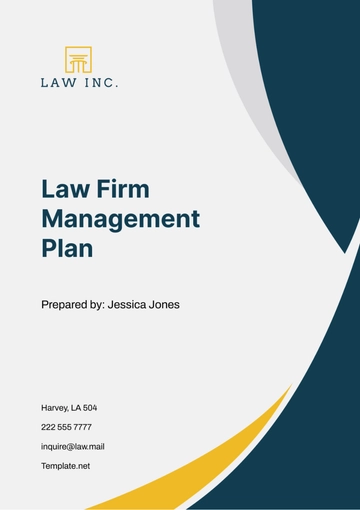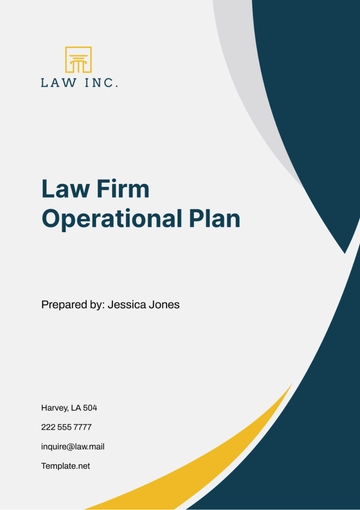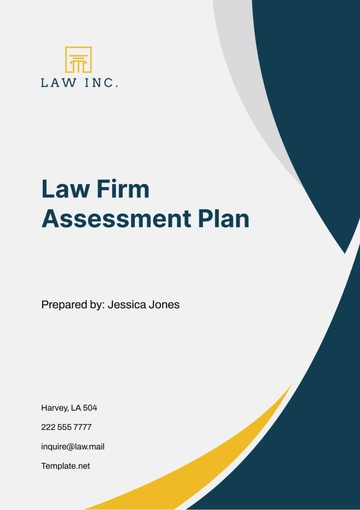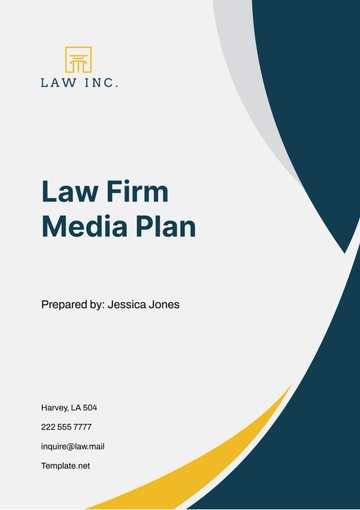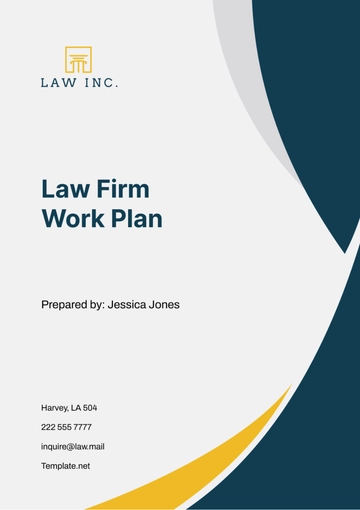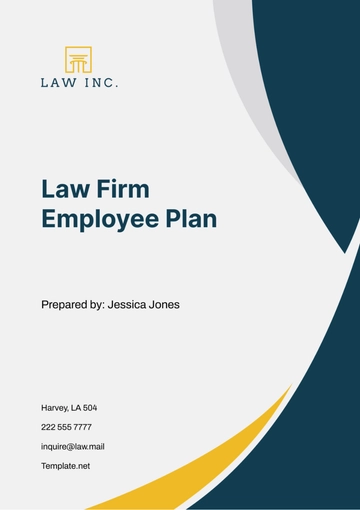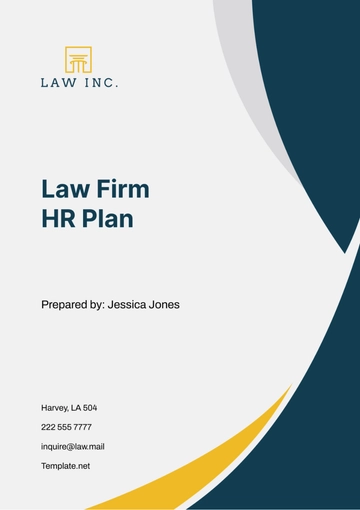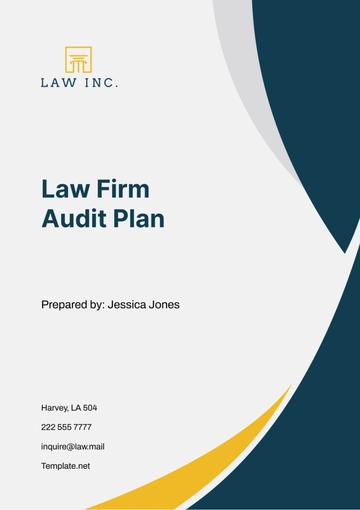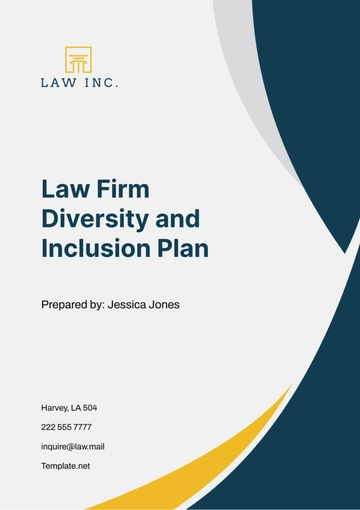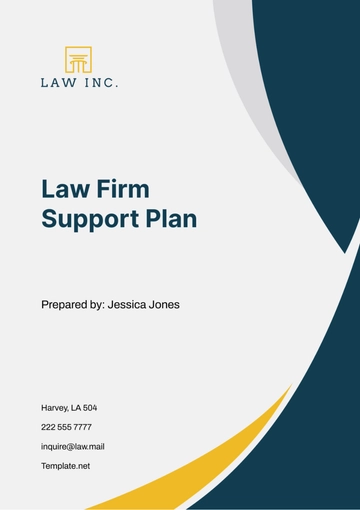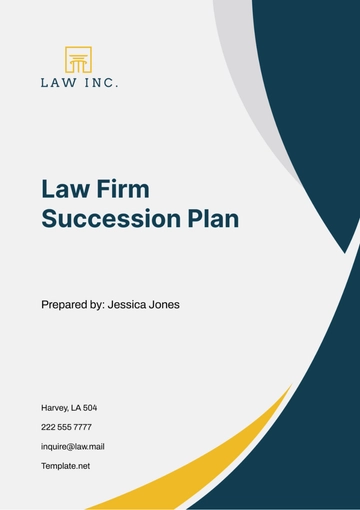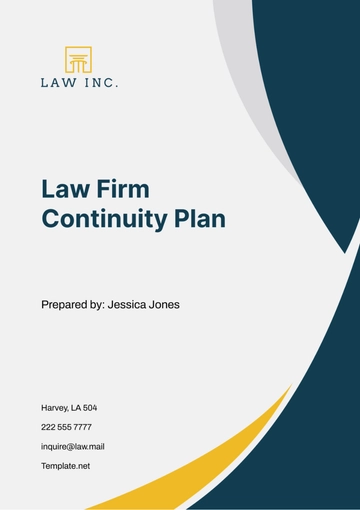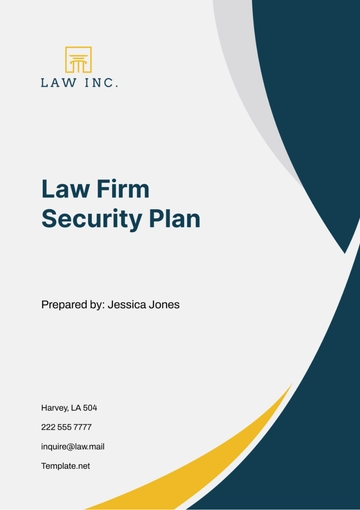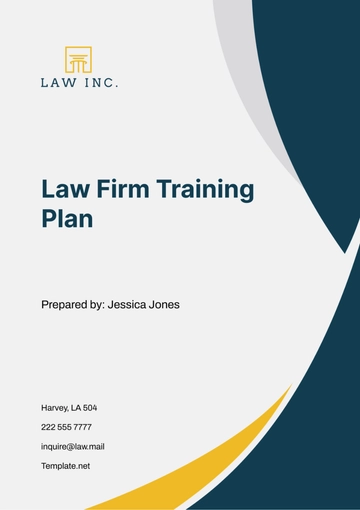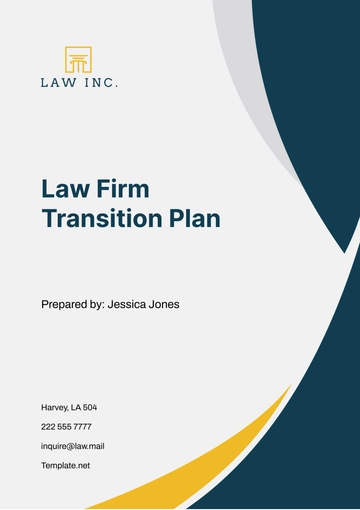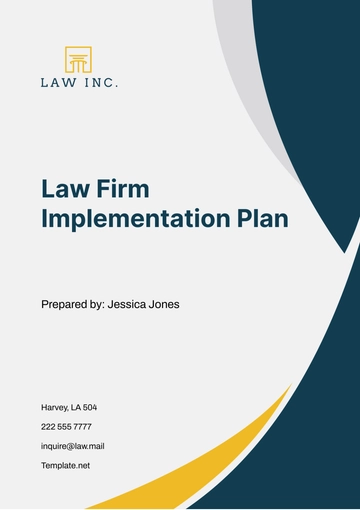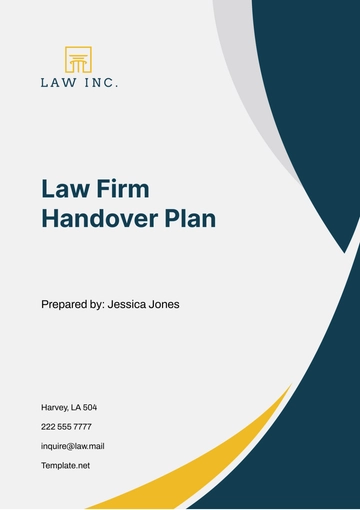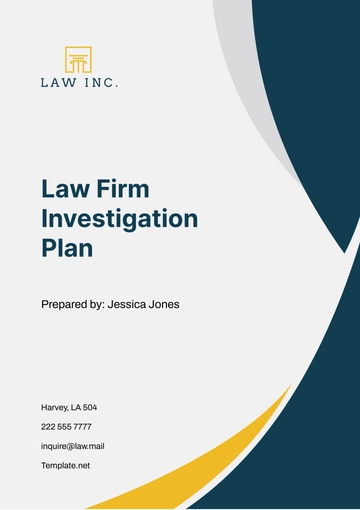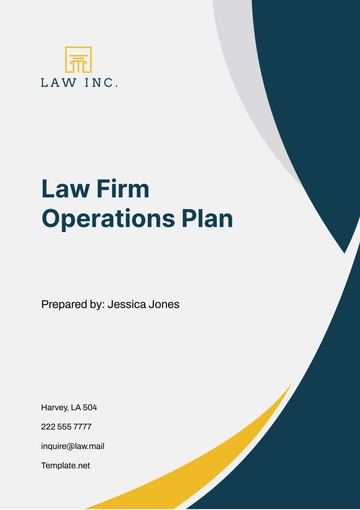Free Law Firm Investigation Plan
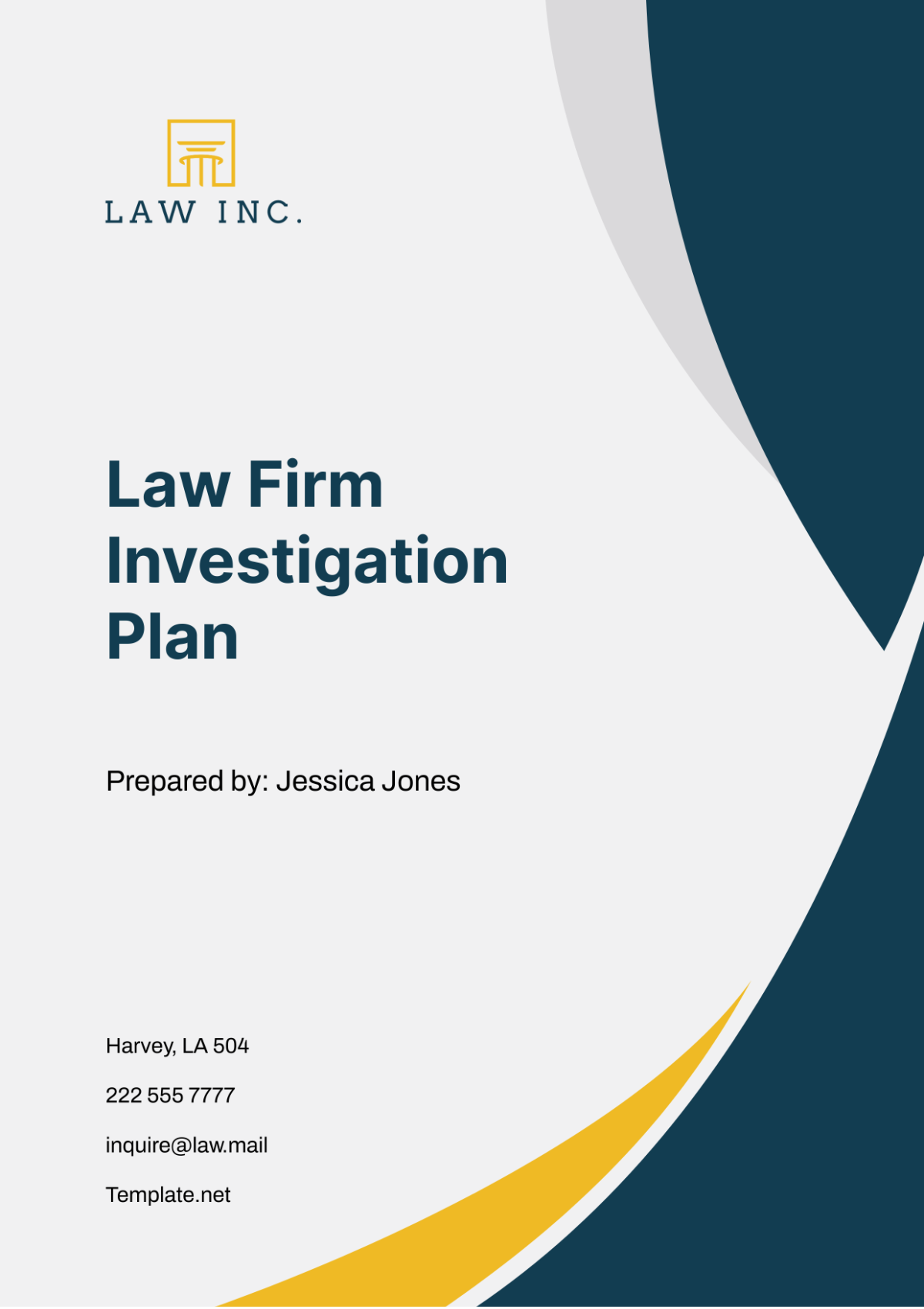
A. Introduction and Scope
Our investigation aims to provide a comprehensive and meticulous examination of the issues at stake in this particular case. The primary objective is to ensure that all evidentiary opportunities are capitalized upon to further the legal position of our client. We recognize the gravity of the concerns surrounding the operations and practices of [Your Company Name], and our investigation endeavors to address these with utmost diligence and integrity.
The scope of this investigation encompasses all matters directly related to these issues and within the legal boundaries. This includes but is not limited to, an evaluation of resident care protocols, staff training procedures, facility maintenance records, and compliance with state and federal regulations governing nursing home operations. By conducting a thorough examination of these aspects, we aim to provide our client with actionable insights and a robust legal strategy moving forward.
B. Legal Framework and Compliance Considerations
In line with the nature of the investigation, we grasp that adherence to the legal framework and ethical standards is imperative. To this end, our investigation would be built around the relevant laws and regulations, alongside posing regular consultation with the ethical codes of legal practice. A robust strategy will also be put in place to promptly respond to any evolving regulatory changes during the investigation period.
1. Adherence to Laws and Regulations
In line with the nature of the investigation, we grasp that adherence to the legal framework and ethical standards is imperative. Our investigation will be meticulously crafted around the relevant laws and regulations governing nursing home operations in the United States. This includes but is not limited to the Nursing Home Reform Act, the Health Insurance Portability and Accountability Act (HIPAA), and state-specific regulations governing elder care facilities.
2. Ethical Considerations
To ensure ethical integrity throughout the investigation process, we commit to upholding the ethical codes of legal practice. This includes principles such as confidentiality, objectivity, and integrity. Our team will adhere to the American Bar Association's Model Rules of Professional Conduct, as well as any state-specific ethical guidelines applicable to legal investigations.
3. Response to Regulatory Changes
A robust strategy will be put in place to promptly respond to any evolving regulatory changes during the investigation period. This includes monitoring updates to federal and state laws governing nursing home operations and promptly incorporating any necessary adjustments into our investigative approach. By staying abreast of regulatory changes, we ensure that our investigation remains aligned with the current legal landscape and continues to uphold the highest standards of compliance.
C. Investigation Team and Responsibilities
In organizing our investigative efforts, clarity in roles and responsibilities is paramount. This section outlines the composition of our investigation team and delineates their respective duties. By establishing clear lines of accountability, we ensure efficiency and coordination in pursuit of our objectives.
The table below succinctly outlines the roles and responsibilities of each member of our investigation team. By clearly defining these roles, we ensure efficient collaboration and accountability, laying the groundwork for a thorough and effective investigation.
Team Member | Role | Responsibilities |
|---|---|---|
Appointed Lawyer | Lead Investigator | Overall case strategy, leadership |
Paralegal | Assistant Investigator | Research, drafting legal documents, gathering facts |
Investigator | Evidence Handler | Collection, preservation, and analysis of physical and digital evidence |
D. Evidence Gathering and Preservation
In the pursuit of truth and justice, the integrity of evidence is paramount. This section outlines our meticulous approach to gathering and preserving evidence, guided by legal protocol and best practices. By ensuring the admissibility and integrity of evidence, we uphold the principles of fairness and transparency in our investigative process.
Below is an illustration of our methodical process for gathering and preserving evidence. By visually depicting each step, we ensure clarity and consistency in our investigative approach. This systematic framework guides our efforts to uphold the integrity and admissibility of evidence throughout the investigation.
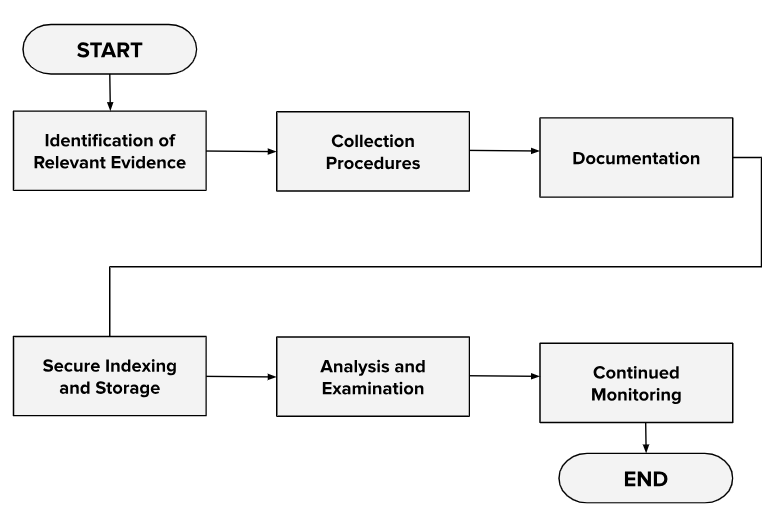
Identification of Relevant Evidence: Identify and document all potential sources of evidence relevant to the case.
Collection Procedures: Utilize legally sound methods to collect physical and digital evidence, ensuring proper chain of custody.
Documentation: Thoroughly document the collection process, including dates, times, and individuals involved.
Secure Indexing and Storage: Safely store all collected evidence in a controlled environment, maintaining its integrity and chain of custody.
Analysis and Examination: Conduct analysis and examination of the evidence using appropriate methodologies and expertise.
Continued Monitoring: Regularly monitor and update the status of collected evidence to ensure its preservation and integrity throughout the investigation process.
E. Data Management and Confidentiality
Given the nature of digital data, the utmost emphasis will be on the secure and confidential management of electronically-stored information. Our approach prioritizes secure storage and retrieval mechanisms, stringent data privacy protocols, and periodic data audits to ensure irreproachable ethical compliance.
In line with this commitment to confidentiality, our firm will utilize encrypted methods for transferring sensitive information. By implementing robust data management practices, we safeguard the privacy rights of all parties involved and uphold the highest standards of ethical conduct throughout the investigation process.
F. Interviews and Witness Statements
Effective interviews and thorough documentation of witness statements are crucial components of any comprehensive investigation. This section outlines our commitment to employing sensitive and legally-bound techniques for gathering accurate information from witnesses. By systematically recording and preserving statements, we uphold the integrity and reliability of our investigative process.
1. Interview Techniques
In conducting interviews with witnesses, the team will employ sensitive and legally-bound techniques to ensure the collection of accurate and reliable information. These techniques include:
a. Open-ended Questioning: Utilizing open-ended questions allows witnesses to provide detailed responses, facilitating a thorough understanding of their perspective.
b. Active Listening: Team members will practice active listening during interviews, attentively focusing on the witness's responses to ensure that all relevant details are captured.
2. Documenting Witness Statements
Systematic approaches will be used to document witness statements accurately and comprehensively. This process includes:
a. Digital Recording: Each interview will be digitally recorded to capture the witness's exact words and tone. This ensures an accurate representation of the information provided during the interview.
b. Transcription: Following the interviews, recordings will be transcribed by qualified professionals. Transcriptions provide written records of the statements, facilitating review and analysis by the investigative team.
3. Preservation of Statements
All witness statements, both audio recordings and transcriptions, will be preserved as integral parts of the investigation materials. This preservation process involves:
a. Secure Storage: Statements will be securely stored in designated repositories to prevent unauthorized access or tampering.
b. Indexing and Organization: Each statement will be indexed and organized according to relevant categories, ensuring ease of access and retrieval during the investigative process.
c. Chain of Custody: A strict chain of custody protocol will be implemented to track the handling and movement of witness statements, maintaining their integrity and admissibility in legal proceedings.
G. Reporting and Communication
Effective reporting and communication are essential pillars of a successful investigation. This section underscores our commitment to keeping the client informed of progress and findings at regular intervals. Through formal reports and confidential communication channels, we ensure transparency, adherence to legal standards, and alignment with client preferences. Clear and timely communication is paramount in achieving our shared objectives.
1. Client Notification
The client will be continuously notified of the investigation's progress at regular intervals defined by the client's preferences. This proactive approach to communication ensures transparency and allows the client to remain informed throughout the investigative process.
2. Formal Reports
Formal reports containing detailed analysis and possible implications of the findings will be prepared and communicated to the client. These reports serve as comprehensive documents that provide insights into the investigation's progress, key findings, and recommended courses of action.
3. Confidentiality
All communication between the investigative team and the client will be conducted in strict confidentiality, adhering firmly to attorney-client privilege. This ensures that sensitive information shared during the investigation remains protected and privileged, safeguarding the client's interests and maintaining the integrity of the legal process.
4. Adherence to Legal Standards
Throughout the reporting and communication process, the investigative team will adhere to the highest standards of legal professionalism and ethics. This includes maintaining accurate records of all communications, ensuring compliance with relevant laws and regulations, and upholding the principles of fairness and impartiality.
5. Client Preferences
The frequency and format of communication will be tailored to the client's preferences and requirements. Whether through in-person meetings, written reports, or electronic communications, the investigative team will adapt to ensure effective and efficient communication based on the client's needs.
H. Investigation Timeline
In any investigative endeavor, a well-defined timeline is essential to ensure organization, efficiency, and accountability. This section outlines our approach to establishing a realistic and comprehensive timeline for the investigation. By providing a detailed schedule of actions, we ensure that all team members remain focused and aligned with the overarching objectives.
Action | Timeline | Responsible Party |
|---|---|---|
Initial Case Assessment | Week 1 | Lead Investigator |
Evidence Collection | Weeks 2-4 | Investigator Team |
Witness Interviews | Weeks 5-7 | Lead Investigator and Assistant Investigator |
Data Analysis | Weeks 8-10 | Data Management Team |
Report Preparation | Weeks 11-12 | Paralegal Team |
Client Review and Feedback | Week 13 | Lead Investigator and Legal Team |
Final Report Submission | Week 14 | Lead Investigator |
I. Contingency Planning
In recognition of the dynamic and unpredictable nature of legal investigations, a robust contingency plan is indispensable. This section outlines our commitment to developing a comprehensive plan that anticipates and addresses potential challenges. By proactively preparing for unexpected scenarios, we ensure agility and resilience in our investigative approach, ultimately enhancing the integrity and effectiveness of our efforts.
1. Development of Contingency Plan
Considering the unpredictable nature of legal investigations, an uncompromising contingency plan will be developed. This plan will effectively provide a roadmap on immediate steps and procedures to follow should any unexpected evidentiary, legal, or regulatory challenges surface.
2. Identification of Potential Challenges
The first step in developing the contingency plan involves identifying potential challenges that may arise during the course of the investigation. These challenges may include but are not limited to, the discovery of new evidence, changes in legal precedents, or unforeseen regulatory requirements.
3. Assessment of Risks and Impact
Once potential challenges are identified, a thorough assessment of risks and their potential impact on the investigation will be conducted. This assessment will help prioritize responses and allocate resources effectively to mitigate risks and minimize disruption to the investigation process.
4. Establishment of Response Protocols
Based on the assessment of risks, response protocols will be established to guide the investigative team on immediate steps and procedures to follow in the event of a contingency. These protocols will outline clear lines of communication, decision-making processes, and escalation procedures to address challenges effectively and efficiently.
5. Regular Review and Updates
The contingency plan will be subject to regular review and updates to ensure its continued relevance and effectiveness. As the investigation progresses and new challenges emerge, the plan will be adjusted accordingly to reflect evolving circumstances and mitigate potential risks.
6. Training and Preparedness
Training sessions will be conducted to ensure that all members of the investigative team are familiar with the contingency plan and understand their roles and responsibilities in its implementation. By fostering a culture of preparedness, we equip the team to respond effectively to any unexpected challenges that may arise during the investigation.
J. Review and Closure
Following the presentation of our findings to the client, the investigation shall be reviewed to ensure all objectives have been fully met and procedures followed as planned. This comprehensive review process ensures the accuracy and integrity of our investigative efforts, providing assurance to all stakeholders.
The closure of the investigation will be formally documented, with all evidence secured and archived appropriately for future reference if needed. By documenting the closure and preserving evidence meticulously, we uphold accountability and maintain a clear record of our investigative process.
- 100% Customizable, free editor
- Access 1 Million+ Templates, photo’s & graphics
- Download or share as a template
- Click and replace photos, graphics, text, backgrounds
- Resize, crop, AI write & more
- Access advanced editor
Conduct thorough inquiries with the Law Firm Investigation Plan Template from Template.net. This editable and customizable template structures the approach for legal investigations, ensuring systematic data collection, analysis, and reporting. Editable in our Ai Editor Tool, it's essential for handling cases efficiently and effectively, providing a clear roadmap to gather evidence, identify witnesses, and prepare for legal proceedings in a methodical manner.
You may also like
- Finance Plan
- Construction Plan
- Sales Plan
- Development Plan
- Career Plan
- Budget Plan
- HR Plan
- Education Plan
- Transition Plan
- Work Plan
- Training Plan
- Communication Plan
- Operation Plan
- Health And Safety Plan
- Strategy Plan
- Professional Development Plan
- Advertising Plan
- Risk Management Plan
- Restaurant Plan
- School Plan
- Nursing Home Patient Care Plan
- Nursing Care Plan
- Plan Event
- Startup Plan
- Social Media Plan
- Staffing Plan
- Annual Plan
- Content Plan
- Payment Plan
- Implementation Plan
- Hotel Plan
- Workout Plan
- Accounting Plan
- Campaign Plan
- Essay Plan
- 30 60 90 Day Plan
- Research Plan
- Recruitment Plan
- 90 Day Plan
- Quarterly Plan
- Emergency Plan
- 5 Year Plan
- Gym Plan
- Personal Plan
- IT and Software Plan
- Treatment Plan
- Real Estate Plan
- Law Firm Plan
- Healthcare Plan
- Improvement Plan
- Media Plan
- 5 Year Business Plan
- Learning Plan
- Marketing Campaign Plan
- Travel Agency Plan
- Cleaning Services Plan
- Interior Design Plan
- Performance Plan
- PR Plan
- Birth Plan
- Life Plan
- SEO Plan
- Disaster Recovery Plan
- Continuity Plan
- Launch Plan
- Legal Plan
- Behavior Plan
- Performance Improvement Plan
- Salon Plan
- Security Plan
- Security Management Plan
- Employee Development Plan
- Quality Plan
- Service Improvement Plan
- Growth Plan
- Incident Response Plan
- Basketball Plan
- Emergency Action Plan
- Product Launch Plan
- Spa Plan
- Employee Training Plan
- Data Analysis Plan
- Employee Action Plan
- Territory Plan
- Audit Plan
- Classroom Plan
- Activity Plan
- Parenting Plan
- Care Plan
- Project Execution Plan
- Exercise Plan
- Internship Plan
- Software Development Plan
- Continuous Improvement Plan
- Leave Plan
- 90 Day Sales Plan
- Advertising Agency Plan
- Employee Transition Plan
- Smart Action Plan
- Workplace Safety Plan
- Behavior Change Plan
- Contingency Plan
- Continuity of Operations Plan
- Health Plan
- Quality Control Plan
- Self Plan
- Sports Development Plan
- Change Management Plan
- Ecommerce Plan
- Personal Financial Plan
- Process Improvement Plan
- 30-60-90 Day Sales Plan
- Crisis Management Plan
- Engagement Plan
- Execution Plan
- Pandemic Plan
- Quality Assurance Plan
- Service Continuity Plan
- Agile Project Plan
- Fundraising Plan
- Job Transition Plan
- Asset Maintenance Plan
- Maintenance Plan
- Software Test Plan
- Staff Training and Development Plan
- 3 Year Plan
- Brand Activation Plan
- Release Plan
- Resource Plan
- Risk Mitigation Plan
- Teacher Plan
- 30 60 90 Day Plan for New Manager
- Food Safety Plan
- Food Truck Plan
- Hiring Plan
- Quality Management Plan
- Wellness Plan
- Behavior Intervention Plan
- Bonus Plan
- Investment Plan
- Maternity Leave Plan
- Pandemic Response Plan
- Succession Planning
- Coaching Plan
- Configuration Management Plan
- Remote Work Plan
- Self Care Plan
- Teaching Plan
- 100-Day Plan
- HACCP Plan
- Student Plan
- Sustainability Plan
- 30 60 90 Day Plan for Interview
- Access Plan
- Site Specific Safety Plan

